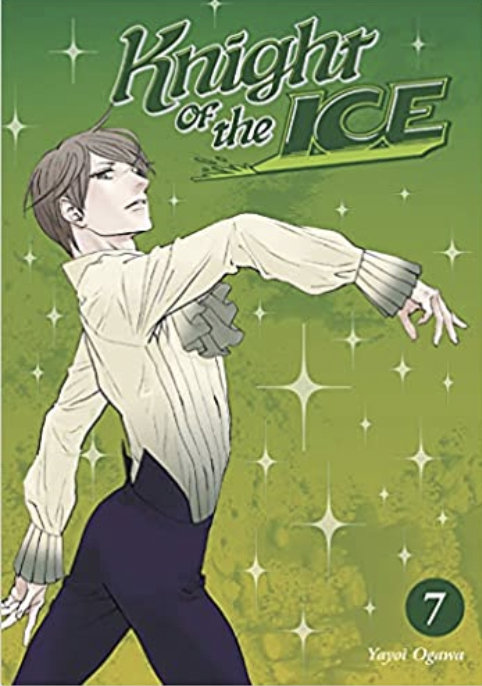Knight of the Ice Volume 7 by Yayoi Ogawa
We don’t get a ton of josei series translated, so I do cherish the ones that come out in print like Knight of the Ice which has a winning combination of figure skating drama combined with Ogawa’s quirky sense of humor. While many of the plot points of the series center around Kokoro’s difficulties training and winning competitions, this volume opens with Chitose dealing with her heart condition. Kokoro’s hard-nosed manager Moriyama visits Chitose in the hospital, and it is great to see how much she cares even though she goes to great lengths to hide her emotions. Chitose doesn’t want to derail Kokoro’s concentration by having him worry about her, so she decides to both postpone having surgery and wants to keep her condition a secret.
For the rest of the volume, Kokoro is vaguely uneasy as he trains for his latest competitions, as he can tell that Chitose is hiding something but he isn’t sure what it is. He’s dealing with his ongoing issues of pushing his technical abilities but sometimes struggling to be artistic and expressive enough in his skating. “Yayoi Ogawa” shows up to dash off a sketch for an inspiring new costume. Ogawa’s dynamic and expressive art makes the skating competitions compelling, as all the skaters are dealing with their own struggles. Kokoro has some triumphs and setbacks, and has still not yet reached his full potential. I’m enjoying seeing the story in Knight of the Ice unfold.


 Daytime Shooting Star, Vol. 1 by Mika Yamamori
Daytime Shooting Star, Vol. 1 by Mika Yamamori Komi Can’t Communicate, Vol. 1 by Tomohito Oda
Komi Can’t Communicate, Vol. 1 by Tomohito Oda Snow White with the Red Hair, Vol. 1 by Sorata Akiduki
Snow White with the Red Hair, Vol. 1 by Sorata Akiduki That Blue Sky Feeling, Vols. 1-2 by Okura and Coma Hashii
That Blue Sky Feeling, Vols. 1-2 by Okura and Coma Hashii Will I Be Single Forever? by Mari Okazaki
Will I Be Single Forever? by Mari Okazaki I had heard good things about Frau Faust and figured I would probably like it too, but I wasn’t prepared for the “OMG, I love this!” feeling that overtook me after the first dozen pages or so. I loved it so much, in fact, that the first seven volumes of Yamazaki’s other published-in-English series, The Ancient Magus’ Bride, are currently on their way to my branch of our awesome local library. If Frau Faust is going to be this original and entertaining, clearly I need to read more of Yamazaki’s work!
I had heard good things about Frau Faust and figured I would probably like it too, but I wasn’t prepared for the “OMG, I love this!” feeling that overtook me after the first dozen pages or so. I loved it so much, in fact, that the first seven volumes of Yamazaki’s other published-in-English series, The Ancient Magus’ Bride, are currently on their way to my branch of our awesome local library. If Frau Faust is going to be this original and entertaining, clearly I need to read more of Yamazaki’s work! After the errand is complete, Marion refuses to let his memories of the encounter be wiped, and tags along with Johanna on her journey to gather the rest of Mephisto, whom she refers to as “my adorable, detestable, unfathomable idiot of a dog.” As the trail leads Johanna to a town where the church is protecting Mephisto’s leg, we learn more about why the demon has been quartered and his parts kept under guard—his only charge is performing an immortality curse upon the dead—and what this means for Johanna. Whenever she sustains an injury, she is able to heal herself, but has a finite supply of physical material to work with, thus she ends up looking younger each time.
After the errand is complete, Marion refuses to let his memories of the encounter be wiped, and tags along with Johanna on her journey to gather the rest of Mephisto, whom she refers to as “my adorable, detestable, unfathomable idiot of a dog.” As the trail leads Johanna to a town where the church is protecting Mephisto’s leg, we learn more about why the demon has been quartered and his parts kept under guard—his only charge is performing an immortality curse upon the dead—and what this means for Johanna. Whenever she sustains an injury, she is able to heal herself, but has a finite supply of physical material to work with, thus she ends up looking younger each time.  It’s 2052 and Tokio Watarai, a dream pilot, is coming home to Japan for the first time in three years. Although his ex-wife and son are in Japan, he’s actually returning for a job involving a girl who’s been sleeping for seven years since being found with her parents’ hearts in her stomach. Her name is Aoba, and when Tokio enters her dream it’s all about an island called Barbara in which kids can fly and cannibalism factors in to funeral rites. Soon, he learns that his son, Kiriya, actually invented Barbara. So how is Aoba able to dream about it?
It’s 2052 and Tokio Watarai, a dream pilot, is coming home to Japan for the first time in three years. Although his ex-wife and son are in Japan, he’s actually returning for a job involving a girl who’s been sleeping for seven years since being found with her parents’ hearts in her stomach. Her name is Aoba, and when Tokio enters her dream it’s all about an island called Barbara in which kids can fly and cannibalism factors in to funeral rites. Soon, he learns that his son, Kiriya, actually invented Barbara. So how is Aoba able to dream about it?  By the end of the first volume, so very many plot threads are in the air that I was not at all sure that Hagio-sensei would be able to make everything make sense in the end. To use just one example: If Barbara is just a dream—and, indeed, no such island actually exists—then how is it possible that the blood of its residents is used for anti-aging medicine? And yet we see evidence that such advances are already in the works. And because of all this plot stuff, there’s not a lot of time for building solid relationships. There is angst aplenty, especially courtesy of Kiriya, but the whole Marienbad/Tokio hookup, for example, is just extremely random. The strongest bond, though, is definitely the love Tokio feels for his son and his regret over having been a crappy father.
By the end of the first volume, so very many plot threads are in the air that I was not at all sure that Hagio-sensei would be able to make everything make sense in the end. To use just one example: If Barbara is just a dream—and, indeed, no such island actually exists—then how is it possible that the blood of its residents is used for anti-aging medicine? And yet we see evidence that such advances are already in the works. And because of all this plot stuff, there’s not a lot of time for building solid relationships. There is angst aplenty, especially courtesy of Kiriya, but the whole Marienbad/Tokio hookup, for example, is just extremely random. The strongest bond, though, is definitely the love Tokio feels for his son and his regret over having been a crappy father. It is definitely a good time to be a manga fan, particularly if you (like me) are fond of niche genres like food manga, sports manga, and cat manga. The latest entry into that final category is Plum Crazy! Tales of a Tiger-Striped Cat and, predictably, it’s cute.
It is definitely a good time to be a manga fan, particularly if you (like me) are fond of niche genres like food manga, sports manga, and cat manga. The latest entry into that final category is Plum Crazy! Tales of a Tiger-Striped Cat and, predictably, it’s cute. Mikuri Moriyama is a 25-year-old licensed clinical psychologist who hasn’t been able to find a job after grad school. She’s been living with her parents and working for a temp agency, and when she’s laid off her father arranges for her to assume housekeeping duties for a guy he used to work with. Hiramasa Tsuzaki is 36 and single. He seems humorless and particular at first, but Mikuri finds that working for a hard-to-please guy makes it easier to know when she’s been successful. She performs her duties well, even managing to nurse Tsuzaki through an illness in such a business-like way that it’s not awkward for him. Things go well for a few months, then Mikuri’s father prepares to retire and move to the countryside. Rather than lose their mutually beneficial arrangement, Mikuri and Tsuzaki decide that she’ll move in with him and, for the sake of propriety, become his common-law wife. They proceed to perpetuate the ruse that they’re actually a real couple.
Mikuri Moriyama is a 25-year-old licensed clinical psychologist who hasn’t been able to find a job after grad school. She’s been living with her parents and working for a temp agency, and when she’s laid off her father arranges for her to assume housekeeping duties for a guy he used to work with. Hiramasa Tsuzaki is 36 and single. He seems humorless and particular at first, but Mikuri finds that working for a hard-to-please guy makes it easier to know when she’s been successful. She performs her duties well, even managing to nurse Tsuzaki through an illness in such a business-like way that it’s not awkward for him. Things go well for a few months, then Mikuri’s father prepares to retire and move to the countryside. Rather than lose their mutually beneficial arrangement, Mikuri and Tsuzaki decide that she’ll move in with him and, for the sake of propriety, become his common-law wife. They proceed to perpetuate the ruse that they’re actually a real couple. As Tsuzaki’s coworkers learn that he’s gotten married, his social calendar suddenly fills up in a way it never did before, while Mikuri notices that her aunt Yuri, with whom she’s very close, has been hesitant to invite her out as much as she used to before Mikuri got married. Spending time with Numata and Kazami is enjoyable for the couple, but it’s also risky, because nosy Numata snoops and learns there’s only a twin bed in the bedroom, and by volume two, Kazami is convinced that they’re faking it. Kazami is perhaps as equally developed as Tsuzaki himself, as we hear a great deal about his reservations about marriage, which all leads up to the big cliffhanger ending of volume two (which I shan’t spoil). Tsuzaki, meanwhile, is attempting in vain to keep from developing feelings for Mikuri. She persists in being business-like, and he 100% believes there’s no chance she’d ever reciprocate, so he often looks emotionless in front of her, only revealing his feelings when he’s alone. I love that neither one of them is spazzy; they’re in a somewhat trope-y arrangement, but they’re handling it like adults.
As Tsuzaki’s coworkers learn that he’s gotten married, his social calendar suddenly fills up in a way it never did before, while Mikuri notices that her aunt Yuri, with whom she’s very close, has been hesitant to invite her out as much as she used to before Mikuri got married. Spending time with Numata and Kazami is enjoyable for the couple, but it’s also risky, because nosy Numata snoops and learns there’s only a twin bed in the bedroom, and by volume two, Kazami is convinced that they’re faking it. Kazami is perhaps as equally developed as Tsuzaki himself, as we hear a great deal about his reservations about marriage, which all leads up to the big cliffhanger ending of volume two (which I shan’t spoil). Tsuzaki, meanwhile, is attempting in vain to keep from developing feelings for Mikuri. She persists in being business-like, and he 100% believes there’s no chance she’d ever reciprocate, so he often looks emotionless in front of her, only revealing his feelings when he’s alone. I love that neither one of them is spazzy; they’re in a somewhat trope-y arrangement, but they’re handling it like adults. I spent all my time wondering “what if,” then one day I woke up and I was 33.
I spent all my time wondering “what if,” then one day I woke up and I was 33. Chihayafuru is a long-running josei sports manga series about a girl who discovers a passion for the Japanese card game,
Chihayafuru is a long-running josei sports manga series about a girl who discovers a passion for the Japanese card game,